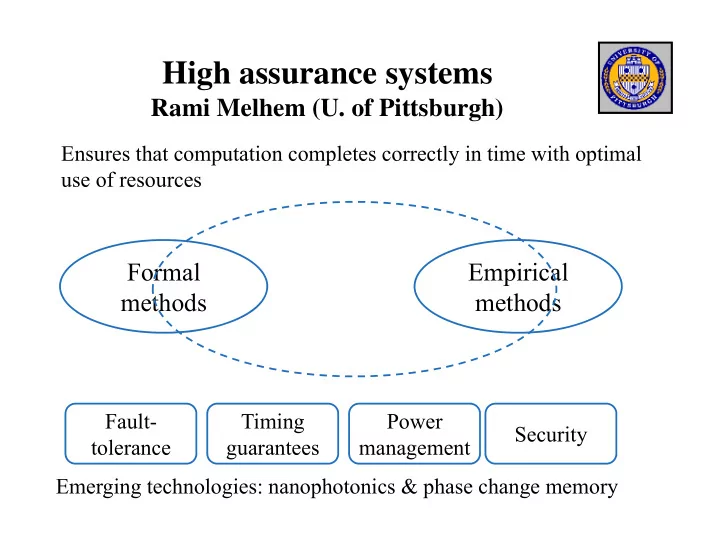

High assurance systems Rami Melhem (U. of Pittsburgh) Ensures that computation completes correctly in time with optimal use of resources Formal Empirical methods methods Fault- Timing Power Security tolerance guarantees management Emerging technologies: nanophotonics & phase change memory
Digital signal μ ring modulator 0111…0010 encode λ m Light wavelength channels λ 1 … λ n Can’t receive signal! Off-chip Photo detector μ ring filter laser decode λ m Waveguide Challenge: Tolerance to process and temperature Variation (PV)
2. New error correction schemes for stuck at faults Phase Change Memory (PCM) A power saving memory technology • Solid State memory made of germanium-antimony alloy • Switching states is thermal based (not electrical based) • Samsung, Intel, Hitachi and IBM developed PCM prototypes (to replace Flash).
Properties of PCM • Non-volatile but faster than Flash • Byte addressable but denser and cheaper than DRAM • Low power read and standby • Not susceptible to single event upsets and hence do not need ECC Errors may occur only during write (not read) • Scalable: at least to 32nm and beyond (9nm) Sounds wonderful – but where is the catch?
The Catch!! • Slower than DRAM, especially for write • Low endurance: a cell fails after 10 7 writes (10 15 for DRAM) • Asymmetric Read/Write energy consumption • Asymmetry of writing 0’s and 1’s Current (hence power) Time (hence bandwidth)
Ongoing work • An error correction scheme for stuck-at fault models – Worn-out cells get stuck at 0/1 but can still be read – A worn-out cell can be classified as either stuck-at- right(SA-R) or stuck-at-wrong(SA-W) depending on the data pattern • Identify a set containing the stuck-at-wrong cells – Some non-faulty(NF) cells could possibly be members of the set but none of the stuck-at-right cells • At read time, invert the values read from the identified set
A Storage Class Memory Architecture for Energy Efficient Data Centers CPU CPU Memory MM AEB Controller DRAM PCM Hybrid architecture Traditional architecture Advantages: cheaper + denser + lower power consumption Challenges: endurance, asymmetry, delay
A cross-layer approach Virtual Machine Virtual Machine Chip multiprocessor Application Application Operating System Operating System Logic Hardware Logic Hardware Hypervisor Conventional VMM Storage system Main Memory I/O controller DRAM SSD HD
1) OPRAM (optimized PRAM) Virtual Machine Virtual Machine Chip multiprocessor Application Application Operating System Operating System Logic Hardware Logic Hardware Hypervisor Conventional VMM Storage system Main Memory I/O controller SSD Optimized HD DRAM PRAM
1) OPRAM (optimized PRAM) • Optimization of PCM for main memory Manage reliability (faults and wear) Manage write latency Manage asymmetric read/write power • Novel interfaces with controller • Run-time monitoring Main Memory Optimized DRAM PRAM
2) MemVisor Virtual Machine Virtual Machine Chip multiprocessor Application Application Operating System Operating System Logic Hardware Logic Hardware Hypervisor Conventional VMM MemVisor Storage system Main Memory I/O controller SSD Optimized HD DRAM PRAM
2) MemVisor • The Memory Resource Advisor to the Hypervisor • Allocates memory resources to virtual machines • Maps data and code to the components of main memory • Considers performance, energy, safety and endurance Hypervisor Conventional VMM MemVisor • Each VM will be managed differently based on Service Level Agreements as well a system wide goals.
3) Intelligent Hybrid controller Virtual Machine Virtual Machine Chip multiprocessor Application Application Operating System Operating System Logic Hardware Logic Hardware Hypervisor Conventional VMM MemVisor Hybrid memory Storage system Main Memory I/O controller controller SSD Optimized HD DRAM PRAM
3) Intelligent Hybrid controller • Dynamically allocates PRAM and DRAM resources • Accepts commands and hints from MemVisor • Monitors usage of memory resources and performance • Provides feedback to MemVisor • Collaborates with MemVisor to improve PRAM endurance • Example: endurance aware cache replacement Hybrid memory Main Memory controller Optimized DRAM PRAM
SCMA (a cross-layer approach) Virtual Machine Virtual Machine Chip multiprocessor Application Application Operating System Operating System Logic Hardware Logic Hardware Hypervisor Conventional VMM MemVisor Hybrid memory Storage system Main Memory I/O controller controller SSD Optimized HD DRAM PRAM
3. Immunity Inspired Cyber Security Defense of complex Body immune information system infrastructures • Highly distributed information processing system • Self protecting • Dynamic • Diverse • Error tolerant
Desirable properties to mimic Learn and retain information for future actions • Local components that interact globally • Individual components are continually created to • improve the system’s defense dangerous components are destroyed and • eliminated from the body Is it a good idea to mimic natural systems?? -- planes do no fly by flapping wings -- cameras?? Concepts already borrowed from biology: • Anomaly detection • Neural networks • Autonomic computing
Is research on protecting critical infrastructures adequate? Is the human factor the "weakest point" in high- assurance systems? Fostering collaboration? Research on critical infrastructures without having access to real systems?
Is research on protecting critical infrastructures adequate? • Threat is over-stated? • Preparation is inadequate? • Opportunity to advance knowledge is always a good thing -- no research is useless (putting a man on the moon??) -- new discoveries are made unexpectedly -- revolutionary Vs evolutionary research
Recommend
More recommend